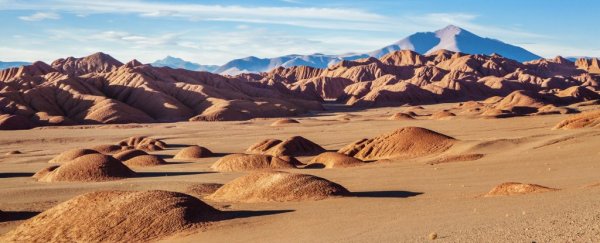Beneath the Andes mountains in South America, Earth's crust is dripping into the planet's interior.
Moreover, this has been occurring for millions of years – a long geological process that has produced telltale wrinkling and other features on the surface that scientists have discerned through modeling and experimentation.
This might help us identify interior geological activity on other planets that don't have plate tectonics, such as Mars and Venus.
It's called lithospheric dripping, and it's only been identified fairly recently here on Earth.
As the rocky crust is warmed up to a certain temperature, it starts to thicken and drip down into the mantle. It's a bit like an extreme pitch drop… but the formation and release of crustal drops has effects on the surrounding surface of the planet.
First, the pull of the drop forming below creates a basin on the surface above. Then, when the drop breaks off, the surface reacts by springing upward, the effects of which spread widely.
"We have confirmed that a deformation on the surface of an area of the Andes Mountains has a large portion of the lithosphere below avalanched away," said geology graduate student and lead author Julia Andersen at the University of Toronto in Canada.
"Owing to its high density, it dripped like cold syrup or honey deeper into the planetary interior and is likely responsible for two major tectonic events in the Central Andes – shifting the surface topography of the region by hundreds of kilometers and both crunching and stretching the surface crust itself."
 A geological map of the Arizaro Basin (left) and the team's experiment (right). (DeCelles, et al.; Julia Andersen et al.)
A geological map of the Arizaro Basin (left) and the team's experiment (right). (DeCelles, et al.; Julia Andersen et al.)
Because scientists have only begun to understand lithospheric dripping recently, the surface response to the process isn't particularly well resolved.
But there are some features of the Central Andean Plateau that have been challenging to explain.
The plateau itself was formed by a subduction zone, where the edge of one tectonic plate slides beneath the edge of the plate adjacent. This deforms the crust, pushing it up and creating mountains and other geological features.
However, there has been evidence to suggest that the formation of the Central Andes was not one long, slow process but occurred in pulses throughout the Cenozoic era, Earth's current geological period, starting around 66 million years ago.
In addition, the timing of uplift isn't consistent across the entire region, as you might expect from subduction. The Puna plateau is higher on average than the Altiplano plateau and contains volcanic centers and isolated basins, such as the Arizaro and Atacama basins.
"Various studies invoke removal of the lithosphere to account for the widespread, non-subduction related surface deformation and evolution of the plateaus," said geologist Russell Pysklywec of the University of Toronto.
"Further, crustal shortening in the Arizaro Basin interior is well documented by folding and local thrust faults, but the basin is not bounded by known tectonic plate boundaries, indicating there is a more localized geodynamic process occurring."
Previous studies have suggested that lithospheric dripping might be at play, but the researchers wanted more concrete evidence.
They designed a laboratory experiment in which they constructed models of Earth's crust and upper mantle to observe what happens on the surface when the crust starts to drip.
The model consisted of a tank and layered materials. A thick, viscous silicone polymer fluid called polydimethylsiloxane formed the lower mantle. The solid upper mantle was a mix of polydimethylsiloxane and modeling clay. Finally, a layer of sand-like spheres of silica and ceramic was the analog for Earth's crust.
"It was like creating and destroying tectonic mountain belts in a sandbox, floating on a simulated pool of magma – all under incredibly precise sub-millimeter measured conditions," Andersen said.
A drip "seed" was inserted into the upper mantle layer. This was pulled slowly downward by gravity, a process that took hours. Meanwhile, a camera observed the entire process, taking high-resolution images every minute or so to capture the deformation of the crust.
These images were then compared against actual geological features in the Andes.
"We compared our model results to geophysical and geological studies conducted in the Central Andes, particularly in the Arizaro Basin, and found that the changes in elevation of the crust caused by the drip in our models track very well with changes in elevation of the Arizaro Basin," Andersen explained.
"We also observed crustal shortening with folds in the model as well as basin-like depressions on the surface, so we're confident that a drip is very likely the cause of the observed deformations in the Andes."
The experiments also showed other ways in which lithospheric dripping may deform Earth's crust. Not all of these were observed in the Andes, suggesting that there may be other regions of the world in which different kinds of dripping may be observed, if we can identify them.
In turn, this also suggests that non-subduction processes may play a more significant role than we realized in shaping the surface of our planet.
The research has been published in Communications Earth & Environment.
